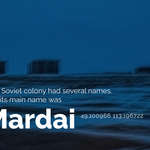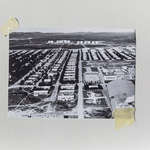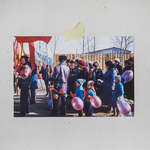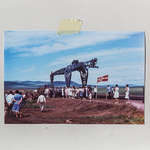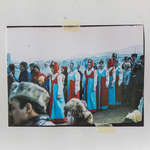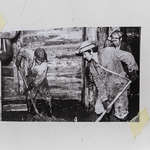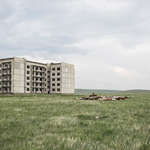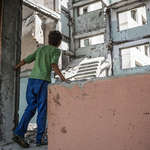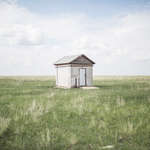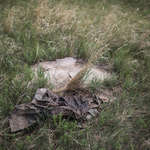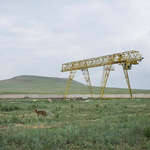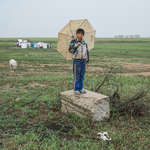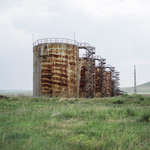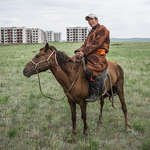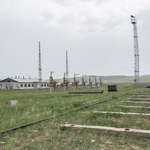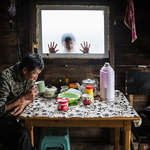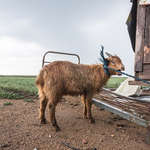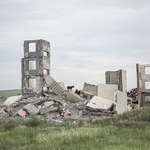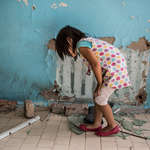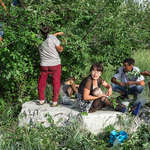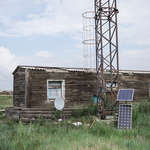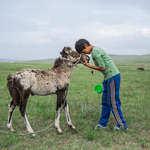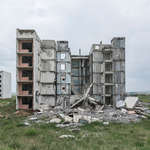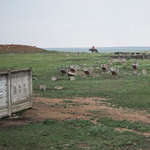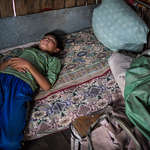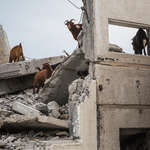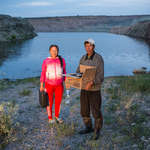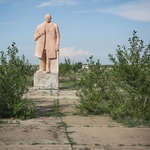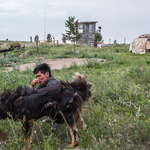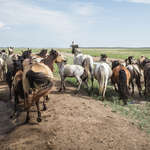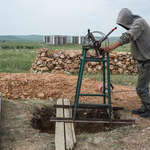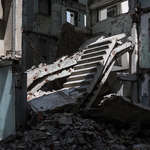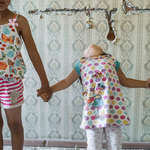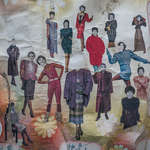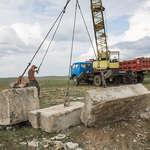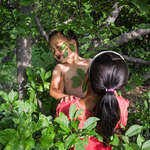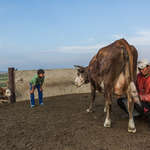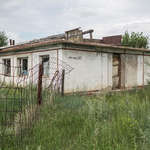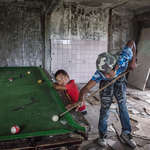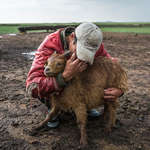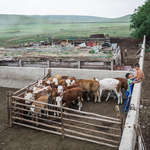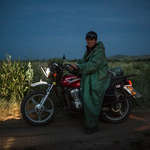
-
[GPS: 49.099552, 114.199529]
In the late 1970s, Soviet geologists discovered large uranium deposits near Mardai River in the Dornod province of Eastern Mongolia. The governments of the USSR and Mongolia signed a secret agreement to open a uranium mine in 1981 and Mardai town rose out of the Mongolian steppe to accommodate workers and officials. Its location and the railroad that connected Mardai to the Soviet Union did not appear on any map. The town was populated only by Russians, who came from all over the USSR. Some 13 000 people lived there in the late 80s and early 90s, while Mongolians were strictly prohibited from entering the Mardai exclusive zone, which was guarded and patrolled by the Russian police and army.
Only on rare occasions were Mongolian Communist Party officials allowed to enter Mardai on official visits and to shop in the local stores for products direct from Moscow. It was the only place in Mongolia where it was possible to buy fresh fruit all year round. Local shops sold items that were not even available Ulan Bator.
-
Mardai had a school and a kindergarten with the best teachers, a fully equipped sports hall, a football and hockey ground, an Olympic size swimming pool and even a ferris wheel.
The mine started operating in 1988; uranium ore was extracted and shipped to Krasnokamensk in Siberia where it was processed. The mine provided about 100,000 tonnes of ore a year, most of which was used for Soviet nuclear warheads and strategic reserves. In 1989, as Mongolia emerged from one-party autocracy, the government revealed the existence of Mardai to the public and when the Soviet Union collapsed two years later, the mine started to receive less money due to the financial crisis in Russia. Uranium production in Mardai stopped in 1995, and Russians reluctantly returned home soon after. The last Russian workers left in 1998.

-
After this “Russian exclave” was given back to Mongolia, locals from the neighbouring towns of Choibalsan and Dashbalbar started to demolish the buildings and infrastructure in search of useful materials, especially scrap metal, which they were sold to Chinese dealers across the border. The wooden houses were taken apart and logs were reused to build new homes. Today, Mardai looks like a town in a warzone and only a few families come there occasionally to continue removing building materials. Others try their luck by digging small illegal mines in search of fluorite.
Only one nomadic family has been living in Mardai permanently for the past 13 years. Bator, the head of the family, takes care of his cattle while his wife Tumenerdene sees to the family household. Every summer they invite a friend’s son, 11-year-old Baira, to come and help Bator with the housekeeping and the animals. In his free time Baira goes to the abandoned buildings to play.
The departing Russians left large amounts of untreated radioactive waste from the former mines and this has been linked by Ryoko Imaoka, an associate professor of Mongolian Studies at Osaka University, to birth defects in livestock which graze around Mardai.
-
Bator tells of a baby goat that was born with its front legs fused to its body. He believes that the grass and water near the mine are contaminated and the Mongolian media has taken up the story, reporting on cancer-related deaths near Mardai.
Despite the parlous environmental condition of the area, Mardai’s uranium deposits, estimated at around 1,307,000 tonnes, still attract the attention of major mining companies. Since the early 2000s Chinese, Canadian, and Russian corporations have been trying to obtain mining licenses and in 2009, President Putin of Russia signed a deal on behalf of the country’s Atomic Energy Corporation with the Mongolian government paving the way for further mining at Mardai. Whether or not Mardai will be rebuilt is unclear. For now, the town stands as a grim reminder of Russia’s colonial exploitation of a neighboring country.
Go to https://pole.media/en/atom/mardai/ to see the multimedia story. Continue scrolling to see the images.
An aerial view of Marda (archival photo from 1980s).
A Labour Day march in Mardai (archival photo from 1980s).
Russians gather near the gantry crane at the petroleum storage depot in Mardai (archival photo from 1980s).
Women wearing traditional Russian national costumes during a celebration in Mardai (archival photo from 1980s).
Russian mine workers in Mardai (archival photo from 1980s).
A man herds sheep and goats in front of an abandoned apartment block in Mardai town.
Baira, 11, plays in the dilapidated building which was built by Russians in the early 1990s. Baira spends every Summer in Mardai, where his parents send him to help their friends with cattle and household chores.
A utility house, one of a few buildings that still remain in the area of the former Mardai International Airport. The airfield was capable of accommodating the very biggest of planes that even today would not be able to land at Ulan-Bator's airport. The existence of Mardai's airport was kept secret for about a decade, with only Russian planes allowed to land there.
The rotting remains of a chemical protection suit lies on the ground at the former Mardai airport. Russian-made cloaks are still very popular with motorcyclists in Mongolia who especially like to use them during the rain.
A gantry crane in an abandoned petroleum storage depot in Mardai. The area of depot was purchased by a local businessmen, who hired a security guard to watch over the property and keep its metallic constructions protected from thieves.
Every year Baira (11) comes to Mardai from his hometown Choibalsan to help Bator and his wife Tumenerdene with their household chores. When Baira has free time he plays with domestic animals or goes to the centre of Mardai to play in a 'treasure hunt' game in abandoned houses.
Oil silos at the abandoned petroleum storage depot in Mardai.
Bator, 45, a herdsman, who has lived in Mardai for the past 13 years. Every day he rides his horse around the city's abandoned apartment blocks to make sure that his cattle don't wander into the dangerously unstable buildings.
An abandoned petroleum storage depot in Mardai.
Bator and Baira take an afternoon tea break from work.
A kid tied up to a Bator's house. Besides his own cattle, Bator takes care of livestock that belongs to the families of ninja-miners that come to Mardai every season.
The ruins of an apartment block in the former downtown of Mardai.
Oyoondaar, 3, plays inside the abandoned mining company office building in Mardai.
People from Dashbalbar sometimes stop in Mardai on their way to the provincial capital Choibalsan to collect 'moil', a berry they use for making jam.
A house of a security guard sited in an abandoned petroleum storage depot in Mardai.
Baira plays with his foal. ' Idid't give him a name yet, I can't choose a good one. Maybe I will call him 'Sar', which means the Moon. His eyes look like a moon, they are very big. Or maybe I will just call him Mardai, says Baira.
Five story apartment blocks that were built at the end of the era of Russian involvement in Mardai. Only a couple were occupied, while the others were still under construction when the Russians abandoned the town.
Bator leading his cattle home through the remains of Soviet era constructions.
Baira rests on his bed after helping Bator to milk cows.
Goats wander among the ruins of an apartment block in the former downtown of Mardai.
Bator, 45 and his wife Tumenerdene, 38, standing near the open uranium pit that was filled with the water before it was abandoned by the Russians. Bator believes that the area around the mine is contaminated.
A statue of Vladimir Lenin in Choibalsan, the biggest town near Mardai, that serves as a Dornod Provincial capital.
A security guard and his dog at the entrance of the Saddle Hills project mining area near Mardai. The Canada-based Western Prospector mining company and its Mongolian subsidiary Emeelt Mines carried out exploration and research activities in the Dornod area. Later Western Prospector was bought by China's CNNC International who are planning to start underground mining from 2018. However the status of the uranium mining licenses in this area is still unclear.
Horses grazing in the Mongolian steppe near the former Mardai airport.
An illegal prospector standing near his fluorite mine in Mardai. Illegal miners come to Mardai on seasonal basis to dig up fluorites. They sell the minerals to a dealers in Khentii Province, who then sell them across the Russian border.
A collapsed staircase in a party destroyed apartment building in Mardai.
The children of families passing through Mardai play inside an abandoned Russian built building.
A collage, from the Soviet era, dedicated to International Women's Day, still remains on a wall in an abandoned mining company office building in Mardai.
Batulga, 21, comes to Mardai every season to remove the concrete blocks that were used for building foundations. They sell them later in Choibalsan town for the price of 90000 Mongolian Tugrik (about 45 US Dollar) each.
Children of illegal fluorite miners play among some trees.
Baira watches how Bator is milking a cow.
An abandoned miner's house on a Druzhby ('Friendship') Street in Mardai.
Budkhuu, 17, playing pool in an abandoned shop in Mardai. Budkhuu and Uuganbayar, five, came to Mardai with their families. Their fathers are illegal seasonal flourite miners. The boys say that playing pool and watching TV is the only entreatment they have in Mardai.
Children in a house that belonged to the family of Russian geologists. Only a few houses were left almost untouched and they are nows used as summer homes by families who come to Mardai looking for scrap metal and concrete blocks. Most of the Mardai houses were ransacked and disassembled by locals in the end of 1990s.
Bator holding a kid goat in his backyard. 'The water we take from the wells and drink here, the grass that animals eat might be not safe', says Bator. 'Once I had a baby goat that was born with two front legs fused to his body. When he grew up a bit, he started walking on his back legs, like a human. Many people came to see it and take photos'. Locals herdsmen believe that the Mardai area is cursed, and most of it's lakes and wells poisoned by radiation which causes birth defects and deformities among their livestock.
Baira plays with a five-year-old Hangal in a corral. Usually Baira spends all his days playing alone, unless a travelling family of nomads with the children stays in Bator's house overnight. Baira uses corral as a place to hide when Bator and his wife are not home. He says 'I'm afraid of the ninja-miners, when I'm alone and I hear the noise of a motorcycle approaching our place, I go and hide behind the calves in a corral and wait till people leave.'
Byambatsogt, 48, a shepherd from Dashbalbar town rides his motorcycle home through Mardai. Mardai is rarely visited by other Mongolians because of its remoteness and its absence on maps.
The remains of the abandoned city of Mardai, easily seen from a long distance over the flat Mongolian steppe. Once seen as the pride of the Soviet military, today Mardai's ruins are a reminder of Russian colonialism, while the underground uranium deposits are still seen as a tasty morsel for big foreign mining companies.
